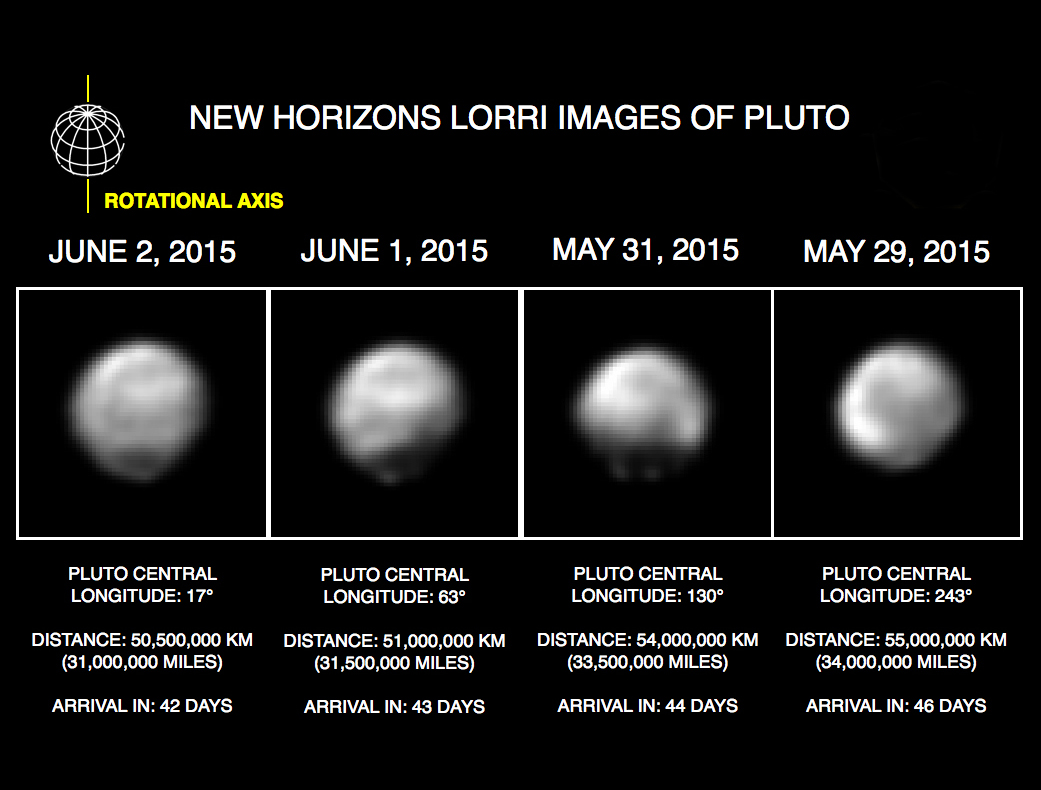The Many Faces Of Pluto Come To Focus in Latest Images From New Horizons
by Sophia Nasr, @Pharaoness
At about 30 million miles (48 million km) from Pluto, the telescopic Long Range Reconnaissance Imager (LORRI) aboard the New Horizons spacecraft has taken a series of images from May 29 to June 2 that reveal the various faces of Pluto as it rotates through its 6.4 day period. These images provide the best glimpse of the dwarf planet to date—and the images will only get better as New Horizons approaches closer.

Using the raw data sent by LORRI, scientists working on the New Horizons mission applied something called deconvolution, a technique that can be used to sharpen images and make them clearer. In addition to using this technique, the contrast was boosted so as to bring out features on Pluto’s surface. You can see the deconvolved image of Pluto below. This technique has been implemented since April to bring out Pluto’s surface features. One such feature is a brighter area near the pole, which may be an ice cap, much like that of Mars. While the technique is a great way of sharpening images, it can sometimes create artifacts in images—that is, stuff that isn’t actually there. But as New Horizons nears the Pluto system, image resolution will increase, and scientists will be able to figure out whether the features seen in the latest images remain or not, and see them clearer.

Another thing to note is that Pluto does not look spherical in the new images. This is actually a result of the image processing performed on the data as well as the variations in surface brightness across the surface of Pluto. Make no mistake, Pluto is a spherical object! One of the many things that we will be able to get more insight on when New Horizons gets close enough to the Pluto system is the cause of the variation in surface brightness—is it due to material on its surface? Its atmosphere? We’ll find out soon enough.
New Horizons Principal Investigator Alan Stern is excited that even at the distance the images were taken, they reveal “an increasingly complex surface with clear evidence of discrete equatorial bright and dark regions—some that may also have variations in brightness.” Stern further said “We can also see that every face of Pluto is different and that Pluto’s northern hemisphere displays substantial dark terrains, though both Pluto’s darkest and its brightest known terrain units are just south of, or on, its equator. Why this is so is an emerging puzzle.” Such surface features are visible in the images above. You can see the different faces of Pluto in the video below, in which images are stitched together to show Pluto as it rotates with its moon Charon in orbit.
“We’ve seen evidence of light and dark spots in Hubble Space Telescope images and in previous New Horizons pictures, but these new images indicate an increasingly complex and nuanced surface. Now, we want to start to learn more about what these various surface units might be and what’s causing them. By early July we will have spectroscopic data to help pinpoint that,” stated Hal Weaver, a New Horizons Project Scientist.
Spectroscopic data is extremely useful, as it can reveal different elements and compounds present in atmospheres. Alice, an ultraviolet imaging spectrometer on the New Horizons Spacecraft, will be able to take such data. With this data, scientists will be able learn more about what Pluto’s atmosphere is composed of. Ralph is the instrument in charge of mapping the surface of the dwarf planet and its moons. Ralph and Alice are coupled instruments in a remote-sensing package (the two were named after Ralph and Alice of “The Honeymooners”). Once the maps are complete, can we expect a Pluto globe? I certainly hope so.
For the original NASA press release, click here.
 Sophia Nasr is an astrophysics student at York University. Actively involved in the astronomical community at York U, she is the President of the Astronomy Club at York University and a member of the team at the York University Observatory. She also is involved in university projects, and holds a position in research on dark matter at York U. Holding scientific outreach dear, Sophia is actively involved in social media outlets such as Facebook, Twitter, and Google Plus, where she shares with the world her passion for the universe and how it works.
Sophia Nasr is an astrophysics student at York University. Actively involved in the astronomical community at York U, she is the President of the Astronomy Club at York University and a member of the team at the York University Observatory. She also is involved in university projects, and holds a position in research on dark matter at York U. Holding scientific outreach dear, Sophia is actively involved in social media outlets such as Facebook, Twitter, and Google Plus, where she shares with the world her passion for the universe and how it works.







